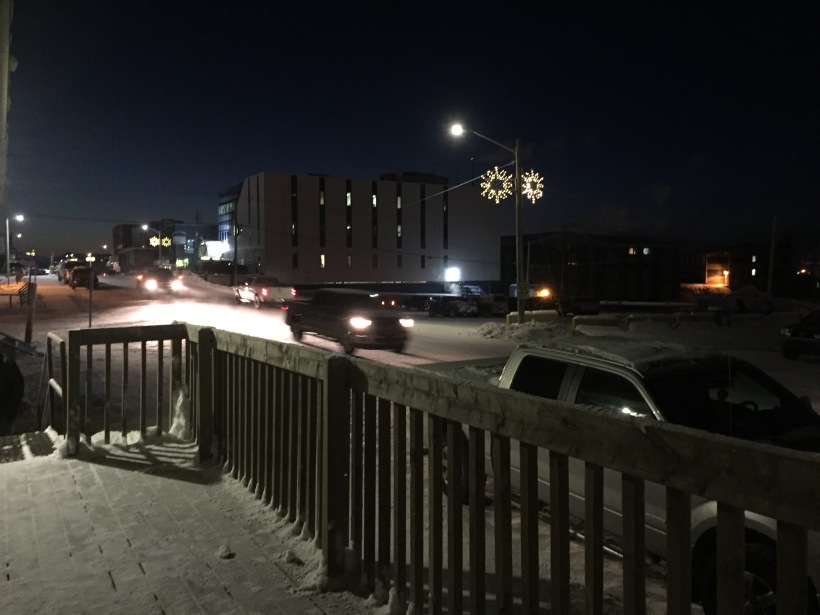3. Do People Go Crazy Here in the Winter?

Next morning while Susan took the boys out for one final dog-sled, Neville and I drove into town for a look around. We ordered coffee in Inuvik’s only cafe, Cafe on Mackenzie, and sat looking out at the dark street. The full moon shone bright above the lights strung across the main street spelling out Merry Christmas, while a shooting star hung above a sign flashing first 10:54 then -18C. Car headlights lit up the white road. People, hunched under heavy clothing hurried between cars and buildings. It was the best coffee we’d had in Canada so far and I told the man behind the counter. He smiled and looked away.
In the silent gift shop next door I looked over the beautifully carved soapstone sculptures. Forbidden to touch the delicate stone, I had to ask the assistant to pick up each one so I could get a closer look. If I made a comment she replied with, “Mmhmm,” but gave me no information other than the price.
“Do people go crazy here in the winter?” I asked.
“They’re used to it,” she replied.
“What do they do?”
“Some people go up to their cabins and go hunting. Do you want these gift-wrapped?”
On our first day, when we dashed into town to find lunch, we sat down on the hard plastic seats in the eating area with our KFC wraps while the locals around us gave us mildly curious sideways glances. In the post office, I asked the man behind the counter how much to send a postcard to Australia.
“One dollar,” he answered with the barest hint of a smile.

Walking around Inuvik it was as though I were followed by a small child who, tugging at my clothing, kept asking, But why are the shops open at night-time? It’s not night-time, I told it, over and over.
But it did feel like I was in a post office at night, and now, having posted my card I had to go back out into the dark. No one wants to be outside in the dark. We want to be inside, where it’s light and warm. Shelter is the only thing that can protect us from the air. But it’s not actually the shelter, but the heat inside it. If this were to shut down, that air would slowly but surely seep in through the pores of the building and find those huddled inside. Perhaps it is this that takes everyone’s attention. Perhaps it’s not that they’re unfriendly so much as distracted. If you were trapped in a building under siege, you would have no time for pleasantries. Pleasantries belong in comfort and ease, two things that cannot exist for long in an Arctic winter.
Everyone seemed drawn in on themselves and I wondered if they were only like this in winter. “Not the cold but the oppression” is how Barry Lopez describes it in his book, Arctic Dreams. Warmth and light draw people out of their houses and out of themselves, but that lethal cold, I felt, and the instinct to withdraw when the dark of night descends kept the people of Inuvik turned inwards. I wondered whether if I returned at the height of summer, when there is no night, people would be more open and friendly.
“We don’t sleep much and get all pumped up on adrenalin,” Susan told us excitedly, about the days of endless sunshine.
That sounded to me like some other kind of hell.

Before going back to the Chalet, we drove down to the Ice Road for another look in the now dim light. High above the frozen water-line sat a ship. It was once used in seismic data collection as part of research into the feasibility of drilling for oil and gas in the Arctic Ocean. Since 1990 she has sat beached above the banks of the Mackenzie river and Ben, one of the volunteers at the Chalet, told us in the summer it is known as being a notorious crack den. He also told us that Inuvik had the highest rate of drug and alcohol abuse per capita in Canada. I couldn’t find statistics to back this up but the fact that in tiny Tuktoyaktuk (Pop: about 950), on the coast at the end of the Ice Road, there is a centre where people can find help for alcohol abuse, speaks of a people desperate for escape. Suicide rates are higher than in southern parts of Canada as are rates of smoking and teenage pregnancy. The findings of a government committee into the health of Canadian youth in the north found “Substance abuse problems in [these] communities are deeply rooted and of long standing. People are beset with feelings of hopelessness, despair and impotent rage. From this comes violence, suicide and sexual abuse.”
As we waited at the airport we watched two police officers in flack jackets shepherd two men in handcuffs onto a plane. As we flew out, I looked down on the chain of frozen lakes and rivers and wondered what could make me return.
